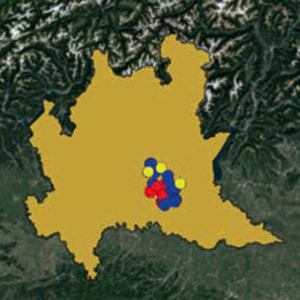Assessment of hail damages in maize using remote sensing and comparison with an insurance assessment: A case study in Lombardy

Accepted: 4 October 2022
HTML: 15
All claims expressed in this article are solely those of the authors and do not necessarily represent those of their affiliated organizations, or those of the publisher, the editors and the reviewers. Any product that may be evaluated in this article or claim that may be made by its manufacturer is not guaranteed or endorsed by the publisher.
Studies have shown that the quantification of hail damage is generally inaccurate and is influenced by the experience of the field surveyors/technicians. To overcome this problem, the vegetation indices retrieved by remote sensing, can be used to get information about the hail damage. The aim of this work is the detection of medium-low damages (i.e., between 10 and 30% of the gross saleable production) using the much-used normalized difference vegetation index (NDVI) in comparison with alternative vegetation indices (i.e., ARVI, MCARI, SAVI, MSAVI, MSAVI2) and their change from pre-event to post-event in five hailstorms in Lombardy in 2018. Seventy-four overlapping scenes (10% cloud cover) were collected from the Sentinel-2 in the spring-summer period of 2018 in the Brescia district (Lombardy). An unsupervised classification was carried out to automatically identify the maize fields (grain and silage), testing the change detection approach by searching for damage by hail and strong wind in the Lombardy plain of Brescia. A database of 125 field surveys (average size 4 Ha) after the hailstorm collected from the insurance service allowed for the selection of the dates on which the event occurred and provided a proxy of the extent of the damage (in % of the decrease of the yield). Hail and strong wind damages ranged from 5 to 70%, and they were used for comparison with the satellite image change detection. The differences in the vegetation indices obtained by Sentinel 2 before and after the hailstorm and the insurance assessments of damage after the events were compared to assess the degree of concordance. The modified soil-adjusted vegetation index outperformed other vegetation indices in detecting hail-related damages with the highest accuracy (73.3%). On the other hand, the NDVI resulted in scarce performance ranking last of the six indices, with an accuracy of 65.3%. Future research will evaluate how much uncertainty can be found in the method’s limitations with vegetation indices derived from satellites, how much is due to errors in estimating damage to the ground, and how much is due to other causes.
Highlights
- The discovery rate of damaged fields improved.
- MSAVI outperformed NDVI and other vegetation indices, identifying 73.3% of occurrences.
- Estimation of damage from remote sensing was more accurate for fields severely affected >50%.
- In low-intensity hail events (<50 canopies affected), the MSAVI provided a detailed picture of the damage across the field.
- The proposed approach is promising to develop a ‘sampling map’ for detailed on-ground assessment.
How to Cite

This work is licensed under a Creative Commons Attribution-NonCommercial 4.0 International License.
PAGEPress has chosen to apply the Creative Commons Attribution NonCommercial 4.0 International License (CC BY-NC 4.0) to all manuscripts to be published.

 https://doi.org/10.4081/ija.2022.2126
https://doi.org/10.4081/ija.2022.2126







